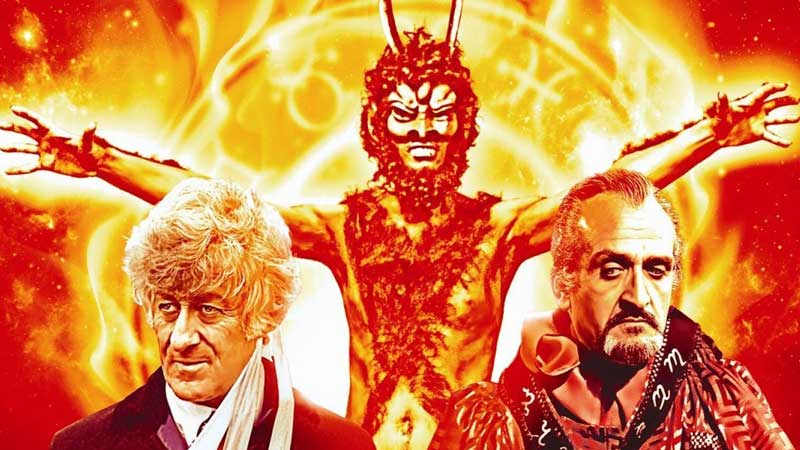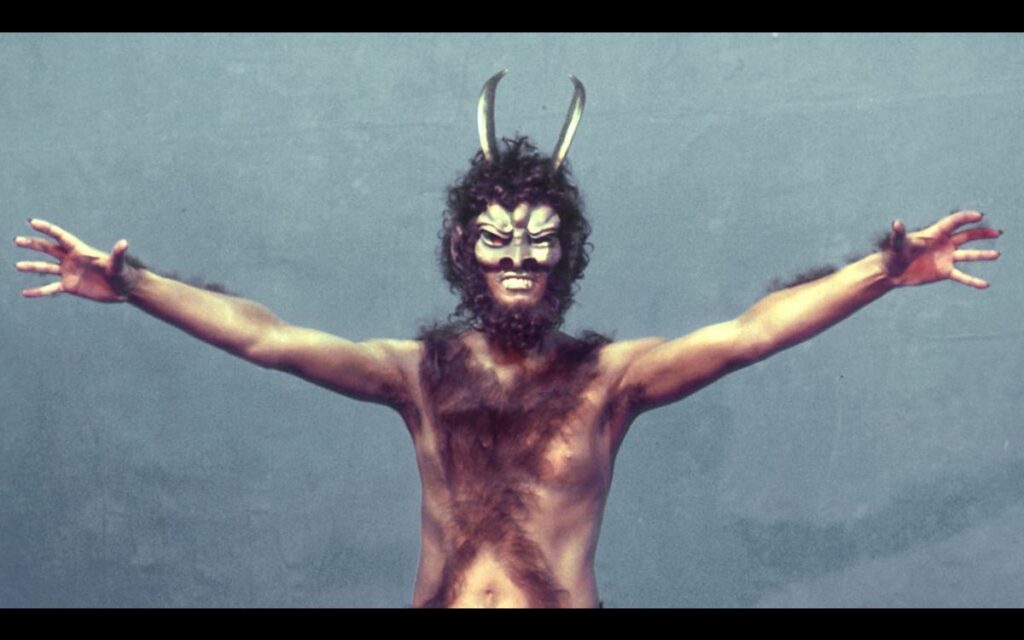CHRIS NEWTON reveals some interesting facts about 1971 Dr Who serial The Daemons…

The 1971 Doctor Who serial ‘The Daemons’ is widely regarded as the greatest episode of The Third Doctor’s era and seen by many as one of the best episodes of classic Who. Many of those who worked on it, including Jon Pertwee, Katy Manning and Nicholas Courtney have all cited it as their favourite. Here are 10 things you might not know about Doctor Who’s dalliance with black magic…
1. This story originated as Katy Manning’s audition piece.
Doctor Who producer Barry Letts had been fascinated by black magic and the occult ever since reading Dennis Wheatley’s novel The Devil Rides Out at the age of 12. When auditioning actresses for the role of the Third Doctor’s new companion, Jo Grant, Letts wrote an audition piece featuring Captain Yates rescuing Jo from a church, written specifically because it required her to be scared, brave and scream in the same scene.
“After he’s found her,” Letts described it “he throws a book onto a strangely carved stone, and the book is immediately torn to shreds by a force like an elemental piranha fish; waiting to tear her apart just as effectively. And at the very end Jo turns round and sees the Devil.”
He remarked to Terrance Dicks, the script editor, that it was a shame they couldn’t really do a black magic episode, to which Dicks replied. “Well, why not?” And said that the story could work as long as the Doctor explained any hocus pocus as alien technology so advanced as to be indistinguishable from magic.
2. Guy Leopold Doesn’t exist
The Daemons was co-written by Barry Letts and Robert Sloman. In the 1970s, however, producers writing scripts for their own series faced potential problems with the Writer’s guild. Also, Sloman was in a writing Partnership with Laurence Dobie at the time and didn’t want people to think the partnership had split up, so the serial was credited as being written by Guy (the name of Sloman’s son) Leopold (Lett’s middle name.)
3. Olive Hawthorne was originally a “daffy” rural spinster.
Described in the script as ‘a somewhat eccentrically dressed lady in her fifties’, Director Christopher Barry initially saw the character as something of a fuddy-duddy and wanted her played for laughs. However, actress Damaris Hayman, who believed in the occult, felt that he was patronising the character.
Hayman wanted to play Miss Hawthorne straight and give her real powers. Fortunately, the Head of Serials, Ronnie Marsh, had worked with Hayman in his days as an actor and said to Barry “Let her alone, she knows what she’s doing!” Barry eventually conceded that Hayman was right to play the character the way she did. Olive Hawthorne proved to be such a popular and enduring character that in 2017 Hayman, now 88, returned to the role for the Reeltime Pictures six-part drama ‘The White Witch of Devil’s End.’
4. The village of Aldbourne is proud of its Doctor Who heritage…
Christopher Barry spent several weeks visiting long barrows in the south of England in search of a location for The Daemons, and whilst the short barrows near Aldbourne were not quite what he had in mind, their proximity to what he called ‘the perfect village’ resulted in the Doctor Who cast and crew descending on the Wiltshire village on Tuesday 20th April 1971.
The locals were apparently delighted by their presence, with many of the villagers appearing as extras in the serial, and, between filming, Jon Pertwee would take the children for rides around the village in the Doctor’s car ‘Bessie’.
Many of the residents can be seen in the final scene in which The Master is driven away by UNIT soldiers. As Roger Delgado passed, the village children all cheered, and Christopher Barry had to reshoot the scene, having insisted that they boo him instead.
If you visit Aldbourne today you will find the village largely unchanged since 1971, and whilst the pub by the village green is, in reality, ‘The Blue Boar’, you will see a large ‘Cloven Hoof’ sign by its entrance. The original Cloven Hoof sign was given to the pub as a souvenir by the production team and remained on display in the bar for many years until the landlord retired and took it with him.
The replica sign (which is actually a bin) was painted by a local artist who is also responsible for the Dalek shaped bins seen elsewhere in the village. Numerous publicity images from The Daemons are on display in The Blue Boar, and there is even a copy of The Daemons DVD in the local heritage centre.
The Cloven Hoof sign was not embraced by everyone, however. During filming, a couple viewing a nearby house were put off by the sign and – believing that was the pub’s real name – told the estate agent they didn’t want to live in a village full of Devil worshippers! Which brings us onto fact number five…
5. … But Christians weren’t very happy about it.
Whilst The Daemon’s greatest inspiration, The Devil Rides Out was written in 1934, the Hammer film version was not made until 1968 as Satanism and black magic were considered highly controversial topics. Considering The Daemons was only made three years later, it’s hardly surprising that it too encountered similar opposition.
Originally the Master’s black mass was to take place in the church itself, but even attempts to relocate the satanic activity to ‘the crypt’ were considered too blasphemous, and the area beneath the church could only be referred to as ‘the cavern’. (Although, in the script, there is still a reference to Sergeant Benton running down ‘the aisle’ in episode five.)
Part of the ceremony was also to involve the backwards recitation of The Lord’s Prayer, which was also deemed unacceptable and the Masters’ eventual line “Malelt Tilad Ahyram” is actually “Mary had a little lamb” backwards. (Interestingly, Delgado adlibbed another backwards incantation: “Hamyah Siramad” in honour of his co-star.)
Other censorship changes included Olive’s ‘talisman’ being changed from a crucifix to an ankh, references to Azal as the ‘horned god’ being amended to ‘horned beast’ and a shot depicting The Master raising his knife to Jo being cut altogether.
Despite these changes, The Daemons still received its fair share of complaints, especially Episode 5. The model church blown up by the effects department proved to be so effective that many viewers were outraged that the BBC had ‘destroyed’ a real church.
Ray Gould, a former landlord of The Blue Boar, said his daughter was due to get married there shortly after filming and, having seen The Daemons on television, two of her young bridesmaids had to be driven down to Aldbourne from Liverpool to be convinced that the church was still there.
6. ‘The Nastiness’ was actually a black furry hat
In the opening scene, the script refers to a ‘something moving secretly about in the graveyard’. This ‘nastiness’ as the crew referred to it, as was actually Assistant Floor Manager Sue Hedden’s hat. She was also responsible for pouring water down the drain of the gargoyle.

7. Devil’s End End’s neighbouring villages also have Satanic names.
The Doctor and Jo’s arrival in Devil’s End is delayed by a spinning signpost. Closer inspection reveals the other locations on the sign are: Satanhall, Witchwood, Abbotsburn and Covenstone.
8. “Mr. Magister” is not the only Time Lord with a Latin alias in this serial.
The Doctor proclaims himself to be “The Great Wizard Quiquaequod”. This word is an amalgamation of the male, female and neutral Latin words for ‘who’.
9. The production took inspiration from Man, Myth and Magic.
Man, Myth and Magic was a British weekly magazine on magic and the supernatural originally published in the 1970s, which the makers of The Daemons relied upon heavily for many of the images, facts and incantations seen and heard in The Daemons. The Doctor’s slideshow includes an image of the ram-headed Khnum, the Egyptian god of The River Nile, and ‘The Witches’ Sabbath by Goya.
The image of the primitive dancing figures is from Maurice Bessy’s Pictorial History of Magic and the Supernatural and the ‘Hindu demon’ is a Rakhasa (or ‘Black Angel’) as pictured in Muhammad al Sudi’s ‘Treatise on Astrology and Divination’.
In Episode One of The Daemons, during her confrontation with the reporter, Miss Hawthorne says she has “consulted the Talisman of Mercury”, which is part of the Key of Solomon in Kabalistic magic, used to summon spirits and acquire secret knowledge. She then makes the mano cornuto gesture (Devil Horns) which, before its heavy metal connotations, was a sign occultists used to ward of evil forces.
10. Bok is more frightening than you think.
The gargoyle Bok – whose design was based on the sculptured gargoyles of Notre Dame Cathedral – was played by Stanley Mason. The costume consisted of a leotard with mask, wings and tail, but a stationary polystyrene Bok, with a moving head and eyes which lit up red was also made for the scenes in the cavern.
After filming of The Daemons, Jon Pertwee took the prop and found a home for it in his garden where, according to Pertwee, it once scared away a would-be-burglar. This wasn’t the first time Bok had given somebody a fright off-camera.
His mask and wings were left hanging up in the wardrobe department one night, and the cleaner who stumbled upon them at 5am the next day got such a fright that she fainted, cracking her head open on a desk as she fell.
This lead to a letter being sent from the BBC top brass insuring a famous instruction to the arts department: “Monsters will be covered at night.”
Tell us your thoughts on The Daemons in the comments section below!
Read Doctor Who’s 10 Scariest Moments








I’m a big Doctor Who fan and I have this story on DVD. My personal favourite story though is ”The Green Death”. Filmed very close to my former home town of Bargoed, near Caerphilly.